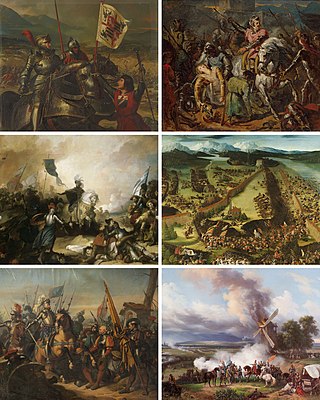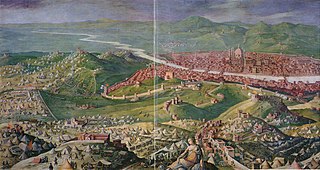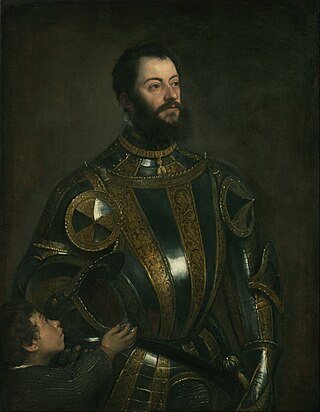
The Italian Wars were a series of conflicts fought between 1494 and 1559, mostly in the Italian Peninsula, but later expanding into Flanders, the Rhineland and Mediterranean Sea. The primary belligerents were the Valois kings of France, on one side, and their opponents in the Holy Roman Empire and Spain on the other. At different points, various Italian states participated in the war, some on both sides, with limited involvement from England, Switzerland, and the Ottoman Empire.

The Landsknechte, also rendered as Landsknechts or Lansquenets, were German mercenaries used in pike and shot formations during the early modern period. Consisting predominantly of pikemen and supporting foot soldiers, their front line was formed by Doppelsöldner renowned for their use of Zweihänder and arquebus. They formed the bulk of the Holy Roman Empire's Imperial Army from the late 15th century to the early 17th century, fighting in the Habsburg-Valois wars, the Habsburg-Ottoman wars, and the European wars of religion.

The Battle of Pavia, fought on the morning of 24 February 1525, was the decisive engagement of the Italian War of 1521–1526 between the Kingdom of France and the Habsburg Empire of Charles V, Holy Roman Emperor as well as ruler of Spain, Austria, the Low Countries, and the Two Sicilies.

Condottieri were Italian military leaders during the Middle Ages and the early modern period. The definition originally applied only to commanders of mercenary companies, condottiero in medieval Italian meaning 'contractor' and condotta being the contract by which the condottieri put themselves in the service of a city or lord. The term, however, came to refer to all the famed Italian military leaders of the Renaissance, Reformation and Counter-Reformation eras. Notable condottieri include Prospero Colonna, Giovanni dalle Bande Nere, Cesare Borgia, the Marquis of Pescara, Andrea Doria, and the Duke of Parma. They served Popes and other European monarchs and states during the Italian Wars and the European wars of religion.

The War of the League of Cognac (1526–30) was fought between the Habsburg dominions of Charles V—primarily the Holy Roman Empire and Spain—and the League of Cognac, an alliance including the Kingdom of France, Pope Clement VII, the Republic of Venice, the Kingdom of England, the Duchy of Milan, and the Republic of Florence.

The Treaty of Cambrai, also known as the Paz de las Damas or Paix des Dames, was an agreement made on 3 August 1529 that ended the French involvement in the War of the League of Cognac between the French king Francis I and the Spanish Habsburg emperor Charles V. The treaty temporarily confirmed Spanish (Habsburg) hegemony in the Duchy of Milan and in Southern Italy.

Fernando Francesco d'Ávalos d'Aquino, 5th Marquess of Pescara, , was an Italian (Neapolitan) condottiero and nobleman of Spanish (Aragonese) origin. He was an important military leader in the service of Spain and the Holy Roman Empire during the Italian Wars.

The Battle of Bicocca or La Bicocca was fought on 27 April 1522, during the Italian War of 1521–26. A combined French and Venetian force under Odet de Foix, Vicomte de Lautrec, was decisively defeated by an Imperial–Spanish and Papal army under the overall command of Prospero Colonna. Lautrec then withdrew from Lombardy, leaving the Duchy of Milan in Imperial hands.

The Italian War of 1521–1526, sometimes known as the Four Years' War, was a part of the Italian Wars. The war pitted Francis I of France and the Republic of Venice against the Holy Roman Emperor Charles V, Henry VIII of England, and the Papal States. It arose from animosity over the election of Charles as Emperor in 1519–1520 and from Pope Leo X's need to ally with Charles against Martin Luther.

Ludovico de' Medici, also known as Giovanni delle Bande Nere was an Italian condottiero. He is known for leading the Black Bands and serving valiantly in military combat under his third cousins, Pope Leo X and Pope Clement VII, in the War of Urbino and the War of the League of Cognac, respectively.

The siege of Florence took place from 24 October 1529 to 10 August 1530, at the end of the War of the League of Cognac. At the Congress of Bologna, the Medici Pope Clement VII and Emperor Charles V agreed to restore the Medici family in Florence. A large Imperial and Spanish army under Philibert of Châlon, Prince of Orange and Pier Maria III de' Rossi surrounded the city and after a siege of nearly ten months, captured it. They overthrew the Republic of Florence and installed Alessandro de' Medici as the ruler of the city.

Pike and shot was a historical infantry tactical formation that first appeared during the late 15th and early 16th centuries, and was used until the development of the bayonet in the late 17th century. This type of formation combined soldiers armed with pikes and soldiers armed with arquebuses and/or muskets. Other weapons such as swords, halberds, and crossbows were also sometimes used. The formation was initially developed by the Holy Roman Imperial (Landsknechte) and Spanish (Tercios) infantries, and later by the Dutch and Swedish armies in the 17th century.

Alfonso d'Avalos d'Aquino, 6th Marquis of Pescara, 2nd Marquis of Vasto, was an Italian condottiero of Aragonese origins, renowned for his service in favour of Charles V, Holy Roman Emperor and King of Spain.
The Black Band was a formation of 16th century mercenaries, largely pikemen, probably serving as Landsknechts. They fought in the French army for ten years, seeing service in several notable engagements, including the Battle of Marignano and the Battle of Pavia.

The Italian campaign of 1524–1525 was the final significant action of the Italian War of 1521–1526 launched by the French into Northern Italy. Led by Francis I of France, the French attempted to dislodge the Habsburgs from Italy in an attempt to control Italy for themselves. After the French invaded Lombardy, the campaign would then primarily consist of the French attempt to capture the city of Milan. However, after Francis's defeat at the Siege of Pavia, the French were driven out of Italy and Francis was taken prisoner.
The Battle of Landriano took place on 21 June 1529, between the French army under Comte de Saint-Pol and the Imperial–Spanish army commanded by Don Antonio de Leyva, Duke of Terranova in the context of the War of the League of Cognac. The French army was destroyed and the battle's strategic result was that the struggle between Francis I of France and Charles V, Holy Roman Emperor for control of northern Italy was temporarily at an end.

The Battle of the Sesia or Battle of the Sesia River, took place near the Sesia River (Latin: Sesites or Sessite), situated in north-western Italy, Lombardy, on 30 April 1524, where the Imperial–Spanish forces commanded by Don Carlos de Lannoy and Fernando d'Avalos, Marquis of Pescara decisively defeated the French army under the Admiral Guillaume Gouffier, Lord of Bonnivet and the Comte de Saint-Pol, during the Italian War of 1521–1526.

Ludovico Barbiano di Belgiojoso (1488–1530) was an Italian military leader who fought on both sides during the Italian Wars.
















